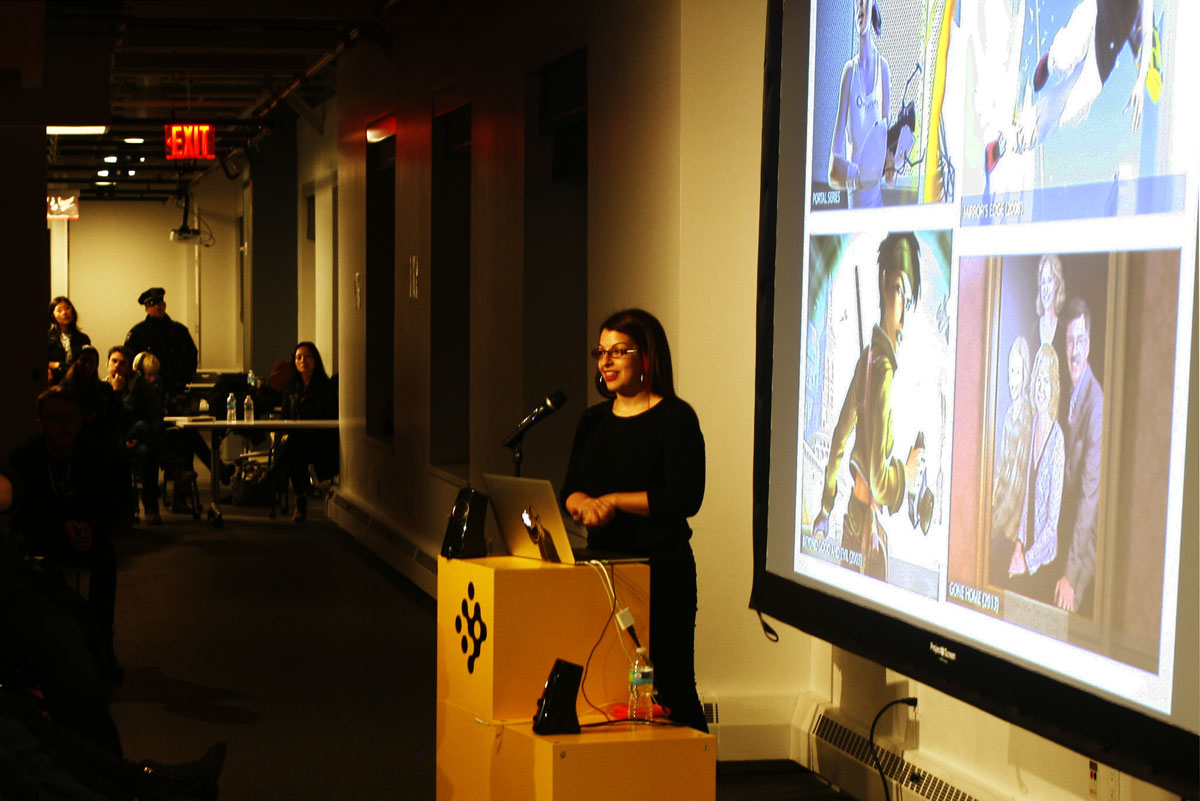During the Q&A following Anita Sarkeesian’s talk at the NYU Game Center last night, she made a distinction between movies and games that helped crystallize why she thinks it’s urgent to talk about games more.
Sarkeesian is the cultural critic behind Feminist Frequency, a website and YouTube channel that may also be the source of information most vilified by adherents of #GamerGate.
Games are different than movies, she explained, because when you watch Bruce Willis play Office John McClane, killing people in the Die Hard franchise, you walk out of the theater saying, “Man, Bruce Willis is awesome.” When you finish playing a video game where your avatar kills a bunch of people, you walk away from the console saying, “Man, I’m awesome.”
It's a full house for @femfreq tonight at @NYUGameCenter! Her talk starts soon. pic.twitter.com/qwyKze80Yk
— Games for Change (@G4C) February 6, 2015
At the same time, however, she points out that that capacity for generating empathy that games can engender is also why improving them is so important. They could be a powerful tool for creating a more nuanced understanding of other people who are different from us.
“I’ve been playing videogames since I was about 5,” Sarkeesian said, but she had to fight with her parents to buy her a Game Boy (the original handheld gaming system), because they believed it wasn’t for her. “Boy” was right there in the name, after all. GamerGaters, she argues, want to keep the world of games a boys club. “A coordinated, organized, all-out assault on women in the games industry,” she said.
Sarkeesian gave eight points on how game makers can make games “less shitty for women.” Here they are:
- Avoid “the Smurfette Principle.” Smurfette was the only female smurf on the cartoon show. A similar trend extends to games. Often times, there’s a slew of characters and they are all male except one token female. “She’s the Smurfette and because she’s the Smurfette, her personality is ‘girl,'” Sarkeesian said. One of the guys might be crazy and and another super tough. Whoever is the Smurfette, however, is a girl and nothing else.
- Lingerie is not armor. She showed the trailer for Perfect Dark 2, in which the female protagonist is seen putting on her underwear, among other sexy things, as she gets ready to save the world. Imagine, she asks the crowd, if they made a trailer like that featuring Master Chief.
- One size does not fit all. Female characters all tend to look exactly the same. Slender, young, leggy and hot. Male characters look all kinds of ways. Short, built, sly, fast and even fat. Men can have all kinds of characteristics but women fit a profile and that profile is titillating, on purpose.
- Butts, butts, butts. The first part of this wasn’t that surprising: there’s a lot of sexy lady butts in games, especially in first person games with female leads. The camera angle, also, tends to follow them from behind and looking up from a little below her butt. The really interesting part, however, was when she showed how hard it is to get a look at the butts of a male character because they are almost always obscured by baggy clothes or a cape (you can kind of get glimpses in God Of War).
- Oh so exotic. When women of color do appear in games, they tend to be depicted as tribal or somehow close to nature in some way, so consistently it relates to stereotypes.
- Something in the way she moves. Female characters tend to move like they are on a runway in heels, she said, not at all like a woman might reasonably be expected to walk if she were about to say, fight a giant troll.
- Something in the way she sounds. Sarkeesian played an audio clip from a League of Legends game featuring a female fighter. It sounded like a sex scene, but, in reality, it was the sound of the female character getting beat up. Making a woman getting hurt sound sexy is obviously creepy. Solution? “Start with trying to make pain actually sound painful rather than orgasmic,” Sarkeesian suggested.
- Where are all the women combatants? She appreciates the reluctance to depict violence against women in games, she said, but the problem with violence is when the character hurt is helpless, passive or victimized. “The ideal here is to design combatants who just happen to be women,” Sarkeesian said. When female characters can be reasonable enemies, not sexy enemies, it gives women parity.

Games Sarkeesian likes: Gone Home, Mirror’s Edge, Beyond Good and Evil and the Portal series. (Photo by Brady Dale)
From a larger perspective, Sarkeesian argued that there should be far more female characters in games, both as playable and non-playable characters — and also a lot more women in the industry.
She also wants to see more kinds of games. The blockbuster games all lead with violence. “We’re going to need to start looking at other mechanics,” Sarkeesian said. Interestingly, the world of board games is having success with all sorts of other mechanics, including games where players cooperate against the game rather than attacking each other.
That said, when you’re pushing for social change IRL, Sarkeesian argues not to bother with the people attacking you:
https://twitter.com/CaseyG/status/563514362539696128
Before you go...
Please consider supporting Technical.ly to keep our independent journalism strong. Unlike most business-focused media outlets, we don’t have a paywall. Instead, we count on your personal and organizational support.
Join our growing Slack community
Join 5,000 tech professionals and entrepreneurs in our community Slack today!
